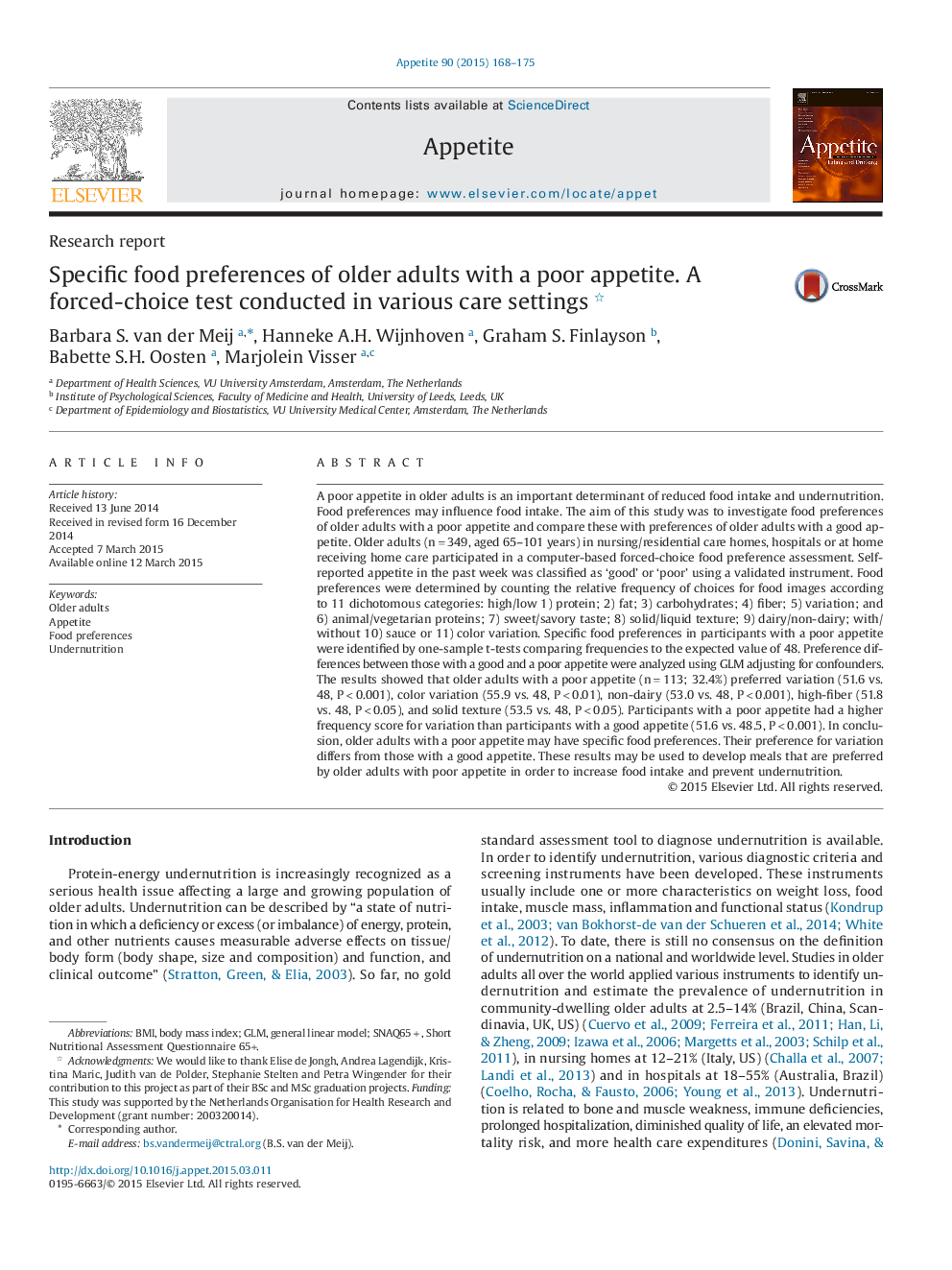| کد مقاله | کد نشریه | سال انتشار | مقاله انگلیسی | نسخه تمام متن |
|---|---|---|---|---|
| 7308900 | 1475390 | 2015 | 8 صفحه PDF | دانلود رایگان |
عنوان انگلیسی مقاله ISI
Specific food preferences of older adults with a poor appetite. A forced-choice test conducted in various care settings
ترجمه فارسی عنوان
تنظیمات غذایی مخصوص افراد مسن با اشتهای ضعیف. یک آزمون انتخابی اجباری در تنظیمات مراقبت های مختلف انجام شده است
دانلود مقاله + سفارش ترجمه
دانلود مقاله ISI انگلیسی
رایگان برای ایرانیان
کلمات کلیدی
موضوعات مرتبط
علوم زیستی و بیوفناوری
علوم کشاورزی و بیولوژیک
دانش تغذیه
چکیده انگلیسی
A poor appetite in older adults is an important determinant of reduced food intake and undernutrition. Food preferences may influence food intake. The aim of this study was to investigate food preferences of older adults with a poor appetite and compare these with preferences of older adults with a good appetite. Older adults (nâ=â349, aged 65-101 years) in nursing/residential care homes, hospitals or at home receiving home care participated in a computer-based forced-choice food preference assessment. Self-reported appetite in the past week was classified as 'good' or 'poor' using a validated instrument. Food preferences were determined by counting the relative frequency of choices for food images according to 11 dichotomous categories: high/low 1) protein; 2) fat; 3) carbohydrates; 4) fiber; 5) variation; and 6) animal/vegetarian proteins; 7) sweet/savory taste; 8) solid/liquid texture; 9) dairy/non-dairy; with/without 10) sauce or 11) color variation. Specific food preferences in participants with a poor appetite were identified by one-sample t-tests comparing frequencies to the expected value of 48. Preference differences between those with a good and a poor appetite were analyzed using GLM adjusting for confounders. The results showed that older adults with a poor appetite (nâ=â113; 32.4%) preferred variation (51.6 vs. 48, Pâ<â0.001), color variation (55.9 vs. 48, Pâ<â0.01), non-dairy (53.0 vs. 48, Pâ<â0.001), high-fiber (51.8 vs. 48, Pâ<â0.05), and solid texture (53.5 vs. 48, Pâ<â0.05). Participants with a poor appetite had a higher frequency score for variation than participants with a good appetite (51.6 vs. 48.5, Pâ<â0.001). In conclusion, older adults with a poor appetite may have specific food preferences. Their preference for variation differs from those with a good appetite. These results may be used to develop meals that are preferred by older adults with poor appetite in order to increase food intake and prevent undernutrition.
ناشر
Database: Elsevier - ScienceDirect (ساینس دایرکت)
Journal: Appetite - Volume 90, 1 July 2015, Pages 168-175
Journal: Appetite - Volume 90, 1 July 2015, Pages 168-175
نویسندگان
Barbara S. van der Meij, Hanneke A.H. Wijnhoven, Graham S. Finlayson, Babette S.H. Oosten, Marjolein Visser,
